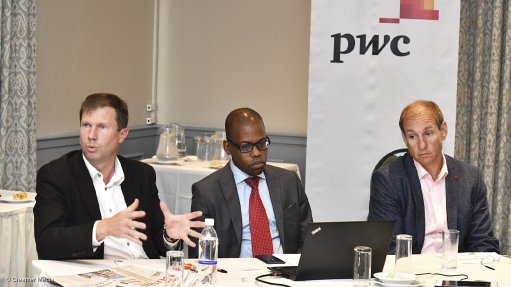
(Left to Right) PwC assurance partner Andries Rossouw, PwC director Sizwe Mtetwa and PwC Africa energy utilities and resources leader Michal Kotzé
Photo by: Creamer Media's Dylan Slater
JOHANNESBURG (miningweekly.com) – The world’s top 40 mining companies continued to consolidate their performance of the past several years by delivering steady growth in 2018, PwC’s ‘Mine 2019’ report, published on Tuesday, states.
Combined, these companies’ revenue had increased by 8% year-on-year, which PwC says was buoyed by higher commodity prices and marginally improved production. The companies also boosted cash flows, paid down debt and provided a record dividend of $43-billion to shareholders during the year.
The steady performance is forecast to continue this year, with revenue remaining stable.
However, weaker coal and copper prices are expected, which will marginally offset higher production and higher average prices for iron-ore.
Further, despite this decent performance in 2018, PwC laments that investors “seem unimpressed” by the top 40 companies’ results, judging by market valuations, which fell by 18% year-on-year.
While total market capitalisation increased in the first quarter of this year, it remains 8% lower than at the end of 2017.
“In spite of the strong operating performance of the world’s top miners, there is still more room for improvement for mining to continue to create and realise value in a sustainable manner,” says PwC Africa energy utilities and resources leader Michal Kotzé.
He adds that both investors and other stakeholders have concerns about the mining industry’s ability to respond to the risk and uncertainties of the changing world.
According to Kotzé, globally, stakeholders are concerned that the industry is lagging when it comes to a number of factors that have not been a traditional focus of the mining industry, such as emissions, investing in differentiating technology, proactive engagement with consumers, brand building and digitisation.
Nevertheless, the mining industry is said to have a window of opportunity to adapt to the growing and changing expectations of stakeholders through using technology to operate safely and more efficiently while addressing global concerns and maintaining a disciplined strategy to create ongoing value for stakeholders.
Meanwhile, in 2018, the top 40 mining companies paid down $15.5-billion in net borrowings, resulting in the gearing position dropping below the ten-year average. All liquidity and solvency ratios improved during the year, leaving the world’s largest miners with strong balance sheets and cash flows.
In line with expectations, capital expenditures (capex) started to rise again, albeit from historically low levels, PwC says. The 13% increase over the previous year to $57-billion suggests that miners are continuing to proceed cautiously; with about half of the capex in 2018 allocated for ongoing projects.
Copper and gold dominated spending in 2018, attracting $30-billion of investment.
Further, an 11% lift in operating cash flows has allowed these 40 mining companies to increase shareholder distributions in 2018 to a record $43-billion. Dividend yield for the year was 5.5%, with a notable jump in share buybacks to $15-billion, up from $4-billion in 2017.
In 2018, the share of value distributed to governments in the form of direct taxes and royalties increased from 19% to 21%. Employees received 22% of the total value distribution from the top 40 mining companies.
According to PwC assurance partner Andries Rossouw, mining, along with oil and gas, distributes a greater share of its value to governments than almost any other sector.
He adds that a number of countries have also implemented carbon taxes and/or emissions trading schemes, with 13 of 25 countries in which the top 40 companies operate, having implemented these taxes and schemes and a further nine countries considering the implementation of such taxes.
In terms of mergers and acquisitions, PwC director Sizwe Mtetwa says that, after years of sluggish activity, these picked up significantly in 2018 with the value of the announced transactions having risen by 137% to $30-billion, driven by “a flurry of activity” in the gold sector, the ongoing push by miners to optimise portfolios and momentum to acquire energy metal projects.
“This renewed appetite for large transactions looks as though it will continue throughout 2019, with the deal value announced to April 30, 2019, already surpassing the value of all the announced deals in 2017,” he comments.
Further, the gold sector is experiencing a renewed round of consolidation, driven by a shrinking pipeline of projects, fewer new high-grade discoveries and a lack of funding for junior developments.
Gold deals increased from 8% of total top 40 deal value in 2017 to 25% in 2018, and this year are tracking at close to 95% of deals as at the end of April.
“Gold mining companies need to be rigorous and disciplined with prospective deals. With substantially all the value generated by mergers and acquisitions between 2005 and 2012 now lost, investors are still reeling from past transactions where [buyers] overpaid for assets,” Kotzé comments.